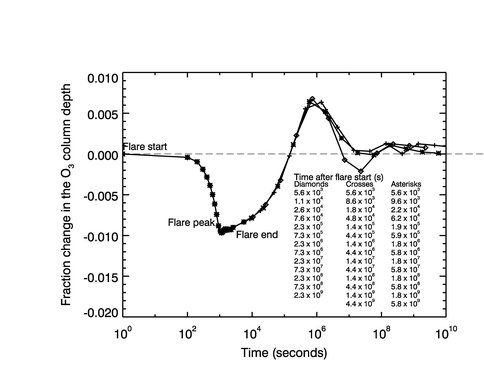2010 Annual Science Report
 VPL at University of Washington
Reporting | SEP 2009 – AUG 2010
VPL at University of Washington
Reporting | SEP 2009 – AUG 2010
Stellar Effects on Planetary Habitability
Project Summary
Habitable environments are most likely to exist in close proximity to a star, and hence a detailed and comprehensive understanding of the effect of the star on planetary habitability is crucial in the pursuit of an inhabited world. We looked at how the Sun’s brightness would have changed with time. We also model how stars with different masses, temperatures and flare activity affect the habitability of planets, including looking at the effect of a very big flare on a planet’s atmosphere and surface. We find that a planet with an atmosphere like Earth orbiting around a cool red star is fairly well protected from UV radiation, but particles associated with the flare can produce damaging chemistry in the planetary atmosphere that severely depletes the planet’s ozone layer.
Project Progress
We worked to enhance a VPL model of for the evolution of solar flux. Understanding changes in solar flux over the age of the solar system is vital for understanding the evolution of planetary atmospheres. The model was based on archival UV and X-ray data for the Sun and young solar analogs, and extended the results of Ribas et al. 2005 into the near UV. Preliminary results were presented at the 215th meeting of the AAS (Claire et al, 2010). We are currently investigating uncertainties in the model with the assistance of a UW undergraduate, and will be publishing the final results during the next performance cycle.
We completed the study of the effect of a large flare on an Earth-like planet in the habitable zone of the active M dwarf, AD Leo (Segura et al., 2010). Based on observations of solar proton events and the Neupert effect, we estimated a proton flux associated with the 1985 big AD Leo flare of 5.9×108 protons/cm2/sr/s/ for particles with energies >10 MeV. We then calculated the abundance of NOx produced by the flare by scaling the production of these compounds during a large historical solar proton event (the Carrington event). Our results indicate that the UV radiation emitted during the flare does not produce a significant change in the ozone column depth of the planet. When the action of protons is included, the ozone depletion reaches a maximum of 94% two years after the flare for a planet with no magnetic field. At the peak of the flare, the calculated UV fluxes that reach the surface, in the wavelength ranges that are damaging for life, exceed those received on Earth for less than 100 seconds. Therefore, flares may not present a direct hazard for life on the surface of an orbiting habitable planet.
We are currently using a 1-D photochemical model to study the effect of a large flare on the chemistry of an abiotic CO2-rich planetary atmosphere located in the habitable zone of AD Leo. Preliminary results show that under stellar quiescent flux, high concentrations of CO are produced by CO2 photolysis, compared to a similar atmosphere around the Sun. During the flare methane and water are photolyzed in the stratrosphere, allowing some UV flux to reach the surface. Preliminary results indicate that for an atmosphere with 0.02 CO2 and 1×10-4 CH4, most of the UV radiation reaches the surface, while in an atmosphere with 0.2 CO2 and 1×10-6 CH4, the ozone from the abiotically produced O2 provides some shielding from UV.
Time evolution of the ozone column depth compared to the initial steady state before, during, and after a big UV flare event. The lines show simulations made with different time steps after the flare ended. Times used for each run are listed
in the figure (Segura et al. 2010).
Time evolution of the ozone column depth compared to the initial steady state. These results show the combined influence of the flare’s incident UV radiation and a proton event at the peak of the flare. Line with diamonds: O3 fraction
change for a simultaneous UV and proton flux peak. Line with crosses: O3 fraction change for a proton event with a maximum delayed by 889 s with respect to the UV flare peak. Vertical dotted lines indicate the time for the peak of the UV
flare and the end of the UV flare (Segura et al. 2010).
Flux received at the top of the atmosphere of a planet on the AD Leo habitable zone (0.16 AU). The dotted line is the solar flux received by Earth. Times listed on the right lower corner of each panel correspond to the flare fluxes plotted on that
panel. AD Leo spectrum during quiescence is always shown in a black continuous line to be used as a reference (Segura et al. 2010).
Publications
-
Segura, A., Walkowicz, L. M., Meadows, V., Kasting, J., & Hawley, S. (2010). The Effect of a Strong Stellar Flare on the Atmospheric Chemistry of an Earth-like Planet Orbiting an M Dwarf. Astrobiology, 10(7), 751–771. doi:10.1089/ast.2009.0376
- Claire, M., Catling, D. & Cohen, M. (2010). ``The Evolution Of Solar Flux From 2nm To 160 Microns: Quantitative Estimates For Planetary Studies’. Bulletin of the American Astronomical Society, 41: p. 433.
- Kasting, J.F. (2010). Stellar radiative effects on habitable zones. Workshop on Redefining the Habitable Zone. Seattle, WA.
-
PROJECT INVESTIGATORS:
-
PROJECT MEMBERS:
David Catling
Co-Investigator
Martin Cohen
Co-Investigator
James Kasting
Co-Investigator
Victoria Meadows
Co-Investigator
-
RELATED OBJECTIVES:
Objective 1.1
Formation and evolution of habitable planets.
Objective 1.2
Indirect and direct astronomical observations of extrasolar habitable planets.
Objective 2.1
Mars exploration.
Objective 4.1
Earth's early biosphere.
Objective 4.3
Effects of extraterrestrial events upon the biosphere
Objective 5.3
Biochemical adaptation to extreme environments
Objective 6.1
Effects of environmental changes on microbial ecosystems
Objective 7.2
Biosignatures to be sought in nearby planetary systems





